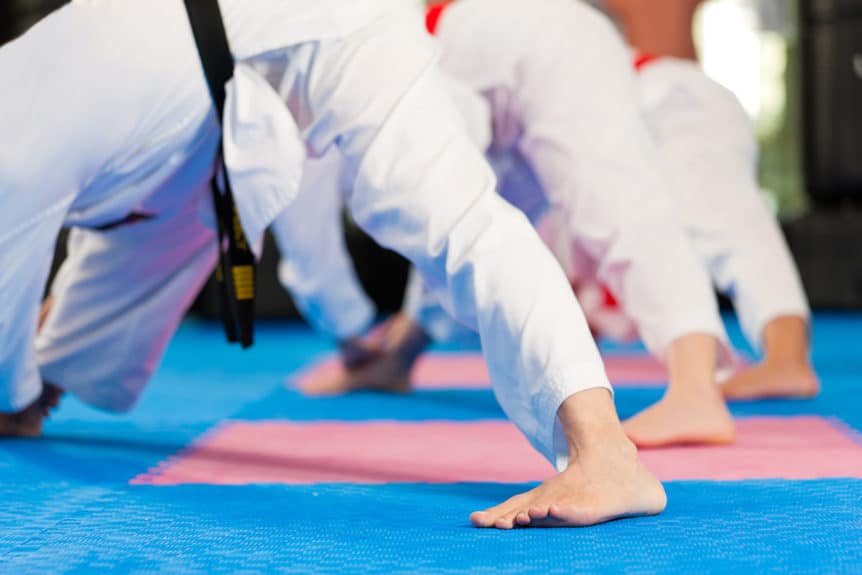
Before you unleash those powerful Taekwondo kicks or flow through your poomsae, there’s one step you can’t skip: a proper warm-up and stretching routine. Whether you’re practicing at home or arriving early at your dojo, these exercises prepare your body for the demands of Taekwondo, no matter your age or skill level.
A solid warm-up boosts your heart rate and blood flow, while targeted stretches enhance flexibility and reduce injury risk. Let’s dive into a 10–15 minute routine that’s tailored for Taekwondo, designed to get you ready to train with confidence.
Why Warm Up and Stretch for Taekwondo?
Warming up and stretching are often overlooked, but they’re the foundation of safe and effective Taekwondo training. A good warm-up raises your body temperature, sending oxygen-rich blood to your muscles, which primes them for the explosive movements of kicks and the precision of poomsae.
Stretching, especially for your hips, hamstrings, and core, improves flexibility, allowing you to achieve higher kicks and smoother transitions. This routine takes just 10–15 minutes, leaving you with a light sweat but plenty of energy for training.
By incorporating both cardiovascular exercises and Taekwondo-specific stretches, you’ll build strength, endurance, and mobility while minimizing the risk of pulls or strains, like the dreaded hamstring injury.
Each exercise should be performed smoothly and gently to avoid overexertion. The routine progresses from standing dynamic warm-ups to floor-based stretches, then back to standing and floor exercises, ensuring a balanced approach. Below, we’ve outlined the exercises in sequence, with a table summarizing their purpose and duration.
Your Taekwondo Warm-Up and Stretching Routine
Start with dynamic movements to get your blood pumping, then transition to static stretches to lengthen key muscle groups. This sequence is designed to prepare your body for Taekwondo’s unique demands, from high roundhouse kicks to stable stances.
Jumping Jacks kick things off with a burst of energy. This classic exercise engages your legs, arms, and core, warming up your entire body while burning calories. Aim for 20–30 reps to get your heart rate up.
Next, Circle Hips loosen your hip joints, essential for fluid kicks. Stand with feet shoulder-width apart and rotate your hips clockwise, then counterclockwise, for 5 rotations each side. Keep your legs stationary to isolate the hips.
The Knee Warmup follows, gently preparing your knee joints. Place your hands on your kneecaps, bend slightly, and rotate your knees in both directions for a count of 20. Move slowly to protect the joints.
Now, ease into stretching with the Short Stretch. Keep one leg straight, bearing your weight, and lift the heel of the other foot while keeping that leg straight. If flexible, lean down and pull back on your foot for a deeper stretch; otherwise, place a hand on your kneecap and lean forward gently.
The Long Stretch builds on this, widening your stance. Keep one leg straight with toes forward, bend the other knee, and turn its toes upward. Lower yourself toward the ground, resting your hands on your bent knee or the floor, and hold for 15 seconds per side.
Finish the standing stretches with the Standing Hamstring Stretch. With feet together, bend at the waist, lowering your forehead toward your knees while keeping your legs straight. Hold for 15–30 seconds to target those injury-prone hamstrings.
Transition to the floor for deeper stretches. The Butterfly Stretch opens your hips and groin. Sit with the soles of your feet together, pull them close to your body, and move your knees up and down for 30 seconds. For a deeper stretch, bend forward with a straight back, holding your feet.
The Open Leg Stretch (sometimes called a pancake stretch) further enhances hip flexibility. Sit with legs spread wide, keeping your back straight. Bend to one side, grabbing your foot or ankle, and pull yourself down for 30 seconds. Return to center, bend forward, and hold the floor or your ankles for another 30 seconds. Repeat on the other side.
The Sitting Hamstring Stretch mirrors its standing counterpart. Extend your legs straight, reach forward, and grab your ankles or feet, keeping your back straight. Hold for 15–30 seconds, repeating 2–3 times for thorough hamstring flexibility.
Stand up for Standing Lunges to build leg strength and stretch hip flexors. Step one leg forward, bending at the knee while keeping your torso upright to avoid knee strain. Perform 10–15 lunges per leg, ensuring proper form.
High Knees (or Knees Up) bring back the cardio. Raise one knee at a time, bouncing slightly, for 30 seconds. For intensity, touch your opposite elbow to each knee as it rises.
Return to the floor for Push Ups to strengthen your upper body and core, aiding balance during kicks. Keep your back straight, bend at the elbows, and lower as close to the floor as possible without touching. Do as many as you can with proper form; beginners can rest knees on the ground.
End with Mountain Climbers for a final cardio burst and core workout. From a push-up position, rapidly alternate bringing each knee toward your chest, as if running in place. Continue for 15–30 seconds, depending on your fitness level.
Exercise Summary
| Exercise | Purpose | Duration/Reps |
|---|---|---|
| Jumping Jacks | Cardiovascular warm-up, engages legs, arms, core | 20–30 reps |
| Circle Hips | Improves hip mobility for kicks | 5 rotations each direction |
| Knee Warmup | Prepares knee joints | 20 rotations each direction |
| Short Stretch | Stretches hamstrings and calves | 15 seconds per side |
| Long Stretch | Enhances hip and hamstring flexibility | 15 seconds per side |
| Standing Hamstring Stretch | Targets hamstrings to prevent injury | 15–30 seconds |
| Butterfly Stretch | Opens hips and groin | 30 seconds |
| Open Leg Stretch | Improves hip and inner thigh flexibility | 30 seconds per side, 30 seconds center |
| Sitting Hamstring Stretch | Deepens hamstring flexibility | 15–30 seconds, 2–3 reps |
| Standing Lunges | Strengthens legs, stretches hip flexors | 10–15 per leg |
| High Knees | Boosts heart rate, strengthens hip flexors | 30 seconds |
| Push Ups | Strengthens upper body and core | As many as possible |
| Mountain Climbers | Enhances core stability and cardio | 15–30 seconds |
Tips for Success
To maximize your warm-up, perform the exercises in the order listed, starting with dynamic movements to raise your heart rate, followed by static stretches to improve flexibility. Always use proper form to avoid injury—check the video demonstration for guidance. If you’re new to Taekwondo, start with fewer reps and shorter stretch durations, gradually increasing as your fitness improves. Listen to your body; if a stretch feels too intense, ease off to prevent strain. For advanced practitioners, consider adding a neck or shoulder warm-up to prepare for upper body techniques.
Final Thoughts
This Taekwondo warm-up and stretching routine is your ticket to stronger kicks, smoother poomsae, and fewer injuries. In just 10–15 minutes, you’ll prime your body for training, whether at home or in the dojo. By making this routine a habit, you’ll boost your flexibility, endurance, and confidence, setting the stage for every session. Ready to get started? Check out the video, follow the sequence, and kick your training up a notch!

